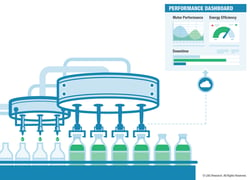Digital Transformation has become one of the most hyped terms in business today. Google it, and you’ll get over 27 million hits in less than a second. Every tech vendor seems to have a blog about how its products or services can help a business with its Digital Transformation journey. With so many resources available, why is achieving true transformation such a struggle? To understand what’s going on, let’s go back to the basics.
Reality Check: Three Definitional Mismatches
According to the Cambridge dictionary, transformation is: “The process of changing completely the character or appearance of something to improve it.” However, most Digital Transformation case studies we see in the market today fail to meet this definition on one or more points.
DEFINITION MISMATCH #1 | In many cases, the focus is on the technology, with little to no thought about the process itself. It is merely an automation project.
 DEFINITION MISMATCH #2 | The second failure point ties to the expression “changing completely.” This is the most common Digital Transformation failure point. If you examine the majority of case studies today about Big Data and analytics (a common Digital Transformation theme), particularly machine learning and artificial intelligence (AI), you find that topic is about:
DEFINITION MISMATCH #2 | The second failure point ties to the expression “changing completely.” This is the most common Digital Transformation failure point. If you examine the majority of case studies today about Big Data and analytics (a common Digital Transformation theme), particularly machine learning and artificial intelligence (AI), you find that topic is about:
- Using predictive analytics to increase reliability and reduce downtime in asset-intensive industries; or
- To improve productivity and/or quality in discrete manufacturing; or
- Reduce risk in regulated industries like pharmaceuticals.
All these examples typically focus on increasing the effectiveness or lowering the cost of an already well-established practice. In some cases, such as asset performance management (APM) or reliability-centered maintenance (RCM) examples, the underlying approach is more than 25 years old. Today’s technology is simply making those things practical from a cost perspective, so companies can apply the strategy to a broader range of assets; it allows for a better value proposition.
DEFINITION MISMATCH #3 | The third way many initiatives fail to meet the transformation “definition test” is they don’t change the character or appearance of the business. After the Digital Transformation project, the business is still doing what it’s always done, just in an improved manner. So, improvement becomes the point the case studies typically revolve around. In reality, the examples so often presented today are not Digital Transformation but rather automation or evolution examples.
More Common Than a White Dolphin
That’s not to say that there aren’t real examples of Digital Transformation in the market today; there are! Companies that shift from a product-centric strategy to a service-centric strategy such as …
- Selling capacity instead of capital goods;
- Selling pound-hours of thrust instead of jet engines; or
- Selling acres plowed, seeded, and harvested instead of tractors and combines…
…are examples of real transformation, but these are the exception instead of the rule. Some of this comes from the fact that customers have yet to adapt to the services model in the business world, although they are moving that way in their personal lives. Today’s millennial and Gen Z workers increasingly opt to rely on public transit and rideshare services for daily transportation needs, and on car-sharing services for more extended trips as opposed to owning a vehicle. Car manufacturers are starting to recognize this, hence their interest in companies like Lyft and Zip Car. However, facing the slow transformation (not evolution) of the market, they are approaching the market cautiously. The question then becomes, “How does a business know what real transformation means for its industry, and how can the company plan for it?”
A New (and Better) Perspective
One mechanism to prepare for real Digital Transformation is to focus on the process change, and to view technology as just an enabler or tool, not the underlying objective. That’s one of the reasons LNS Research has favored the term “Industrial Transformation (IX).” The best way to achieve IX is to:
- Put a framework in place to examine and explain what IX will really look like in your industry;
- Identify the aspects of IX your company needs to adapt and compete in a transformed market; and
- Put in place an architecture to support that metamorphosis and drive the organizational change that will enable your business to achieve it.
None of this means that digitalization projects that drive improvement in an evolutionary fashion aren’t relevant; they are! In fact, they may provide the economic benefit required to begin the IX effort, while also kick-starting the change process.